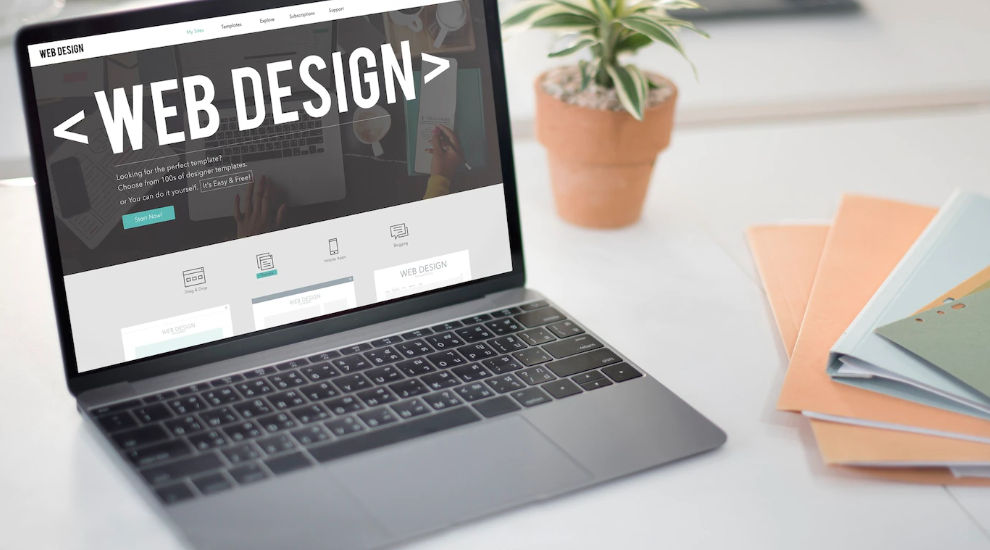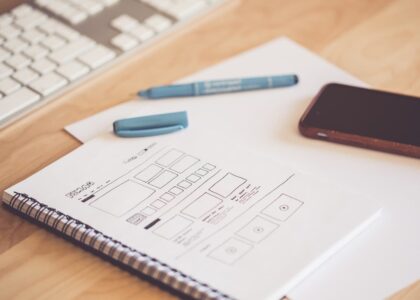Web design is an ever-evolving field, and the basic elements of web design are constantly changing and developing. The fundamental elements of web design refer to the various components that make up a website, such as layout, graphics, and code. These fundamental elements are the basis of all websites and are important for creating a user-friendly website experience.
Layout is one of the most important aspects of web design. Layout is how the website is organized and how it looks visually. It includes elements such as page structure, navigation, page titles, page content, and page formatting. Layout is essential for creating a user-friendly experience, as it makes it easier for visitors to find the information they need quickly.
Graphics are another fundamental element of web design. Graphics can include images, videos, animations, logos, and icons. They are used to make a website visually appealing and engaging. Graphics can also help visitors understand the website’s message and purpose quickly.
Code is the third fundamental element of web design. Code includes HTML, CSS, and JavaScript. These languages are used to create the structure of a website and to control how it looks and functions. Code is essential for making websites interactive and responsive to user input.
Usability is also an important element of web design. Usability refers to how easy it is for visitors to navigate a website and find the information they need. Good usability means that visitors can find what they’re looking for quickly and without frustration. It also includes accessibility features that make sure that everyone can use the website regardless of their disability or impairment.
Finally, SEO (search engine optimization) is an important element of web design. SEO involves optimizing a website so that it appears higher in search engine results pages (SERPs). SEO helps improve visibility for a website, as well as its credibility and trustworthiness. It also helps ensure that visitors find what they’re looking for quickly and easily.
These are the fundamental elements of web design that must be considered when creating any website. By understanding these elements and how they work together, you can create a website that is user-friendly, accessible, and optimized for search engines. This will help ensure that your website is successful and reaches its desired audience.
Colors, Fonts and Images: Enhancing Web Design
Colors, fonts, and images are all elements that play a major role in website design. They’re the building blocks of any great website and can be used to create a visually appealing, professional, and aesthetically pleasing look.
When it comes to colors, the right color palette can make a huge difference in how effective your web design is. Colors should be carefully chosen to match the overall tone and theme of your website. While there is no one-size-fits-all approach to choosing colors for your website, there are some general rules of thumb that you should follow. For example, lighter colors are better for backgrounds, while brighter colors are better for foregrounds. Additionally, you should consider using complementary colors that go well together to create an aesthetically pleasing look.
Fonts also play an important role in web design. The right font can help add personality and clarity to a website. There are a wide range of fonts available, so it’s important to choose the right one for your website. Consider what type of message you want to convey with your font choice. Are you looking for something professional and sophisticated? Or something more playful and inviting? Fonts can also be used to create visual hierarchy on a page, helping visitors quickly identify the most important information.
Images are another key element in web design. They can be used to add visual interest and draw attention to specific elements on a page. Images can also be used to convey a message or tell a story about your business or product. It’s important to choose high-quality images that are relevant to your website’s theme and message. Additionally, you should consider using stock photos or creating custom images to ensure your website looks unique and professional.
By utilizing colors, fonts, and images effectively in web design, you can create an aesthetically pleasing look that will help engage visitors and keep them coming back for more. By carefully selecting the right color palette, font, and images for your website, you’ll be able to create a visually appealing design that will help set your website apart from the competition.
Understanding Usability and User Interface Design
Usability and user interface design are two of the most important aspects of any software or application. In order to understand how to create an effective user interface, it is important to first understand what usability and user interface design are and how they work together.
Usability is the measure of how well a user can interact with a system. It is a measure of how easy it is for a user to learn, use, and navigate a system. It is also a measure of how quickly and accurately a user can perform tasks within the system. Usability can be improved by making sure the system is easy to understand, has a logical structure, and provides helpful feedback.
User interface design is the process of designing the look and feel of a system. It is the visual representation of the system, including buttons, icons, menus, and other elements. A good user interface should be visually appealing, provide an intuitive way for users to interact with the system, and provide helpful feedback.
The two concepts are closely related as usability and user interface design work together to create an effective user experience. A well-designed user interface should make it easy for users to interact with the system, while good usability should ensure that users can quickly complete tasks within the system.
For example, consider an online shopping website. A good user interface design will make it easy for users to find items they want to purchase, while good usability will make sure that users can complete their transactions quickly and without errors.
In order to create an effective user experience, usability and user interface design must be considered together. The user interface should be designed in such a way that it complements the usability of the system. This means that the user interface should be designed to make it easy for users to navigate the system and complete their tasks quickly and accurately.
Creating an effective user experience requires careful consideration of both usability and user interface design. By understanding these concepts and how they work together, developers can create systems that are easy to use, visually appealing, and provide helpful feedback. This will ultimately result in increased user satisfaction and better overall performance of the system.
How to Design Layouts That Are Easy to Navigate

Designing a website or app layout that is easy to navigate is crucial in ensuring that your visitors are able to find what they’re looking for quickly and without getting lost or confused. A well-designed layout can help guide users to the content they need, which can ultimately lead to more conversions and higher engagement rates.
There are several key elements to consider when designing a layout that is easy to navigate. The most important aspect is to create a clear visual hierarchy so that visitors can easily identify the main sections or pages of your website or app. It’s also important to ensure that there is plenty of white space between elements, as this can help reduce clutter and make it easier for visitors to focus on the content they need.
In addition, it’s important to use consistent navigation elements throughout your site or app. This will help create a sense of familiarity for users and make it easier for them to find their way around. For example, you could use the same navigation bar across all pages of your website or app, or you could use icons or labels to help users identify different sections.
Another important aspect of creating an easy-to-navigate layout is to include a search feature. A search feature allows users to quickly find what they’re looking for without having to manually browse through all the content on your site or app. It’s also helpful to include a sitemap page, which allows users to quickly get an overview of the entire site or app and navigate directly to the pages they need.
Finally, it’s important to test your layout with real users before launching it live. This will allow you to get feedback on how easy it is to navigate and make any necessary changes before going live. Testing can also help you identify any potential usability issues that you may have missed during the design process.
By following these tips, you should be able to create layouts that are easy to navigate and help guide your visitors to the content they need. This will help ensure that your visitors have a positive experience on your website or app and increase your chances of achieving your desired goals.
Developing Compelling Content for a Great User Experience
Developing compelling content for a great user experience is essential for any business. It is the foundation upon which a successful digital marketing strategy is built. Content is the key to engaging and retaining customers and driving conversions. Without compelling content, customers will not be interested in the products or services being offered.
Content should be crafted with the user experience in mind. It should be easy to understand and navigate, while providing valuable and relevant information. Content should be tailored to the target audience, and should be written in a way that resonates with them. Content should also be optimized for search engines so that it can be easily found by potential customers.
The content should also be designed with a purpose. It should have a clear call to action, such as signing up for a newsletter or downloading an ebook. This will help to guide users down the desired path and increase conversions. Content should also be engaging and entertaining, as this will keep users coming back for more.
When developing content, it is important to keep it fresh and up-to-date. This means regularly updating blog posts, social media posts, and other content on the website. This will help to keep customers engaged and interested in what the business has to offer. Content should also be optimized for mobile devices, as more and more people are using their phones and tablets to access the web. This will ensure a great user experience regardless of what device they are using.
Lastly, it is important to measure the performance of content. Analytics tools can be used to track engagement levels, time spent on the website, and other metrics that can help determine what content is working and what is not. This data can then be used to improve content for a better user experience.
In conclusion, developing compelling content for a great user experience is an essential part of any successful digital marketing strategy. It should be tailored to the target audience and optimized for search engines, mobile devices, and analytics tools. By creating high-quality content that is engaging and entertaining, businesses can ensure that their customers stay engaged and keep coming back for more.
Creating Responsive Web Design Across All Platforms
Creating a website that works on all platforms is an essential part of any web designer’s job. The rise of mobile devices, combined with the need to make websites accessible to everyone, has created the need for responsive web design. Responsive web design is the practice of creating a website that responds to the user’s device and adjusts its layout, content, and interactions accordingly. This means that regardless of whether someone is using a desktop, laptop, tablet, or smartphone, they will have an optimal experience when visiting a website.
The main goal of responsive web design is to create a website that is flexible and can be viewed on any device. It should be designed to respond to changes in screen size and orientation without sacrificing usability or functionality. This can be achieved by using technologies such as media queries and fluid grids. Media queries allow you to target specific screen sizes and orientations so that your website can be optimized for each device. Fluid grids allow you to create layouts that adapt to different screen sizes, ensuring that your website looks great no matter what device it is being viewed on.
In addition to being device-agnostic, responsive web design also helps to improve user experience. By creating a website that works well across all platforms, users can easily navigate between pages and find the information they need. Additionally, sites that are optimized for mobile devices tend to load faster and have less bandwidth issues than those that are not optimized. This helps to keep visitors on your site longer and increases the likelihood that they will convert into customers.
Finally, creating a website that works on all platforms also helps to improve your search engine rankings. As more people use mobile devices to search the web, search engines are placing an increased emphasis on mobile-friendly websites. By designing a website with responsive web design in mind, you can ensure that your site is optimized for both desktop and mobile searches. This will help you get more organic traffic from search engines and increase the visibility of your website.
Creating a website with responsive web design is essential for any web designer. By using media queries and fluid grids, you can ensure that your website works well across all platforms, improving user experience and increasing your search engine rankings. With the right strategies in place, you can create a website that looks great and works well on any device.
Testing and Optimizing Your Web Design for Maximum Impact
Testing and optimizing your web design for maximum impact is essential to ensure that you are reaching the maximum number of potential customers. A successful website design should be tailored to meet the needs of the target audience and should be easy to navigate and understand. Testing and optimizing your website can help you achieve this goal by providing insight into how visitors interact with your web page, as well as providing data on how to best optimize your design for maximum impact.
The first step in testing and optimizing your web design is to determine who your target audience is. Knowing who you are targeting will allow you to create a website that speaks to their needs, wants, and interests. Once you have identified your target audience, you can begin testing and optimizing your web design. This can include conducting usability testing, which allows you to see how visitors interact with your web page, as well as running analytics to gain insight into how visitors use your website and which elements are most successful.
Once you have collected data on how users interact with your website, it is time to start optimizing for maximum impact. This can include making changes to the content, layout, or design of your website to make it more user-friendly or to make it easier for visitors to find the information they need. Additionally, optimizing your website for search engine optimization (SEO) can help ensure that it ranks highly in search results and that potential customers are able to easily find your website.
When optimizing your web design, it is important to keep in mind that the goal is not just to make your website look better, but also to make it more effective at reaching the right people. This means that you should focus on making sure that the content is relevant and engaging, as well as ensuring that the navigation is easy to use and understand. Additionally, you should optimize the design of your website for mobile devices so that visitors can access your website from any device.
Finally, testing and optimizing your web design is an ongoing process. You should regularly review the data from analytics and usability testing to ensure that you are making changes that are having a positive impact on how visitors interact with your website. Additionally, you should keep an eye on trends in web design so that you can make changes to stay up-to-date with the latest technologies and trends in web design.
By testing and optimizing your web design for maximum impact, you can ensure that you are reaching the right people and making the most of their experience on your website. Through careful analysis of analytics data, usability testing, and staying up-to-date on current trends in web design, you can optimize your website for maximum impact and ensure that it is reaching its full potential.









